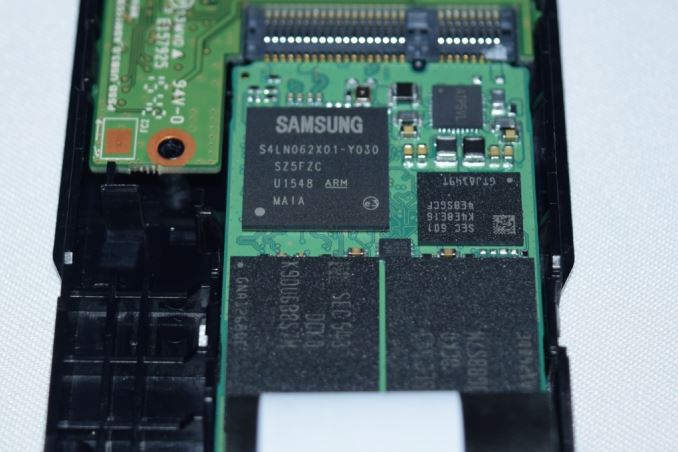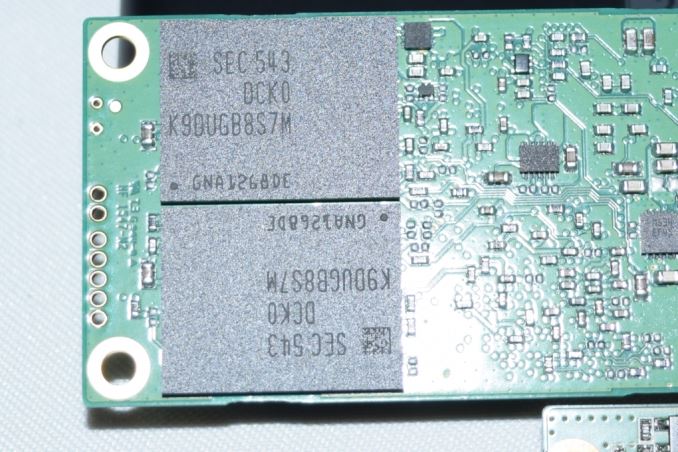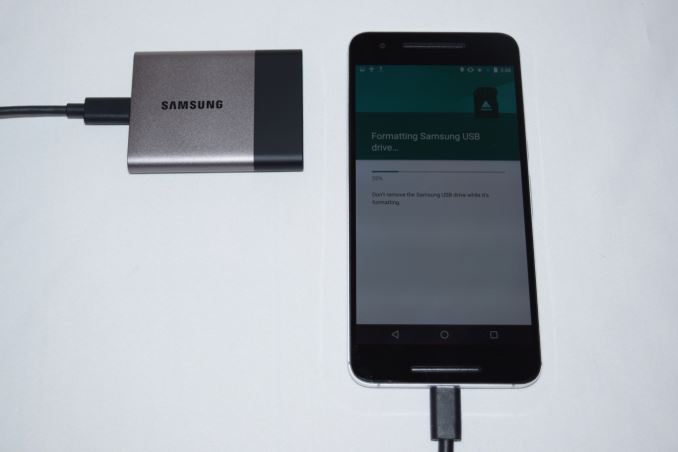Samsung Portable SSD T3 Review
by Ganesh T S on February 22, 2016 10:00 AM EST
The last few years have seen rapid advancements in flash technology including planar 1x nm NAND, TLC, and 3D V-NAND. External high-speed interfaces such as USB 3.x have also become ubiquitous. The advent of Type-C has also enabled device vendors to agree upon a standardized connector for their equipment (be it mobile devices or desktop PCs). These advances have led to the appearance of small and affordable direct attached storage units with very high performance for day-to-day data transfer applications.
Introduction
There are plenty of options for high-capacity thumb drives, but the form factor brings in performance limitations. Therefore, vendors such as Samsung and SanDisk have decided to go in for palm-sized bus-powered units connecting to the host with the help of a cable. Samsung's Portable SSD T1 was released at CES 2015. The Portable SSD T3, announced at CES 2016, builds upon the market success of the T1 and comes with four main improvements:
- Bump in the maximum capacity from 1TB in the T1 to 2TB in the T3
- Migration from a micro-USB connector in the T1 to a USB 3.1 Gen 1 Type-C interface in the T3
- Official compatibility with Android - even for volumes secured with AES-256
- Partial metal enclosure to improve heat dissipation in the T3 compared to the all-plastic T1
The T3 units are slated to become available in the market towards the end of February, but Samsung provided the press with early samples.
The T1 was based on the 850 EVO (same 32-layer TLC V-NAND with a full-fledged MEX/MGX controller coupled with an ASMedia ASM1153E SATA to USB 3.0 bridge). However, the T3 is a bit of a puzzle, since the only 2TB variants we have had from Samsung are the 850 EVO and the 850 PRO. These 2TB variants both use eight 16-die packages (with the only difference being the MLC V-NAND in the Pro to the TLC V-NAND in the EVO). Accommodating eight flash packages in the footprint of the T3 seems like a big stretch, but, before we get into the internals, let us take a look at the insights provided by CrystalDiskInfo.
Even though CrystalDiskInfo reports TRIM as a feature, the quick TRIMCheck program pointed to TRIM availability being indeterminate. In any case, Samsung also doesn't make any claims about TRIM support. S.M.A.R.T data was not visible to most of the commonly used tools. On the USB 3.0 side, the drive supports UASP (USB-attached SCSI Protocol) that should provide increased performance for sequential transfers. Claimed transfer rates are 450 MBps for sequential accesses. We also have hardware-accelerated AES-256 encryption.
In the rest of this section, we will take a look at the internal hardware followed by some usage impressions (particularly from the viewpoint of a DAS unit for an Android device).
Internal Hardware
Compared to the T1, the T3 is much more easy to disassemble. This is not something that any end-user would really care about, but it definitely revealed some interesting information. The process involved peeling off two stickers and taking out four screws. Various pictures from our disassembly process (including shots of the heavy thermal protection) are available in the gallery below.
The last picture in the gallery shows the ASMedia 1153E SATA to USB 3.0 bridge chip (also used in the T1), as well as the ASM1542 10Gbps signal passive switch (used to enable the Type-C interface). The more interesting components are the controller and the flash packages. While the controller (S4LN062X01) seems to be the standard MGX controller used in the 120 - 500GB 850 EVO drives, there are only four flash packages in the system.
Given the 2TB capacity, it is clear that we are looking at flash packages that have not been used in any other publicly available Samsung storage device till now.
Maybe a bit too much flash on the flash?
The flash packages carry the marking K9DUGB8S7M. Since each package has 500 GB of flash, there are three possibilities:
- 32-layer TLC V-NAND, but, 32 dies per package instead of the 16-die ones used in the 850 EVO SATA SSDs
- 32-layer TLC V-NAND, 16 dies per package, but, 256 Gb dies instead of the 128 Gb ones used in the 850 EVO SATA SSDs
- 48-layer TLC V-NAND, 16 dies per package with 256 Gb dies
Without any further details from Samsung, our educated guess is that (c) looks to be the most likely option. The first clue is the pricing. At $850 for 2TB ($0.425/GB), it is not the cheapest external SSD around. The cost per GB is higher than that of the T1 (which launched at $0.60/GB and has now moved down to around $0.34/GB). This leads us to suspect that this is the latest generation TLC V-NAND. An external device like the T3 would allow Samsung to first ship the flash in a low-volume, high-profit part, and then ramp it up for consumer SSDs.There is also less concern about performance and endurance compared to the requirements in internal SSDs. Samsung had also talked about 256 Gb 48-layer TLC V-NAND mass production at FMS last August, and the flash packages in T3 look most likely to be based on that. UPDATE: Samsung confirmed that the NAND used in the Portable SSD T3 is indeed 48-layer 256 Gb TLC V-NAND.
Usage Impressions
Unlike the T1 which came pre-partitioned with a 128 MB FAT32 volume and the rest of the capacity formatted in exFAT, the T3 has only one exFAT partition. Samsung's Portable SSD program can be installed on the PC to enable or disable security (the AES-256 option) as well as to enter the password for drives that have had a password set through another device. We saw in our T1 review that the encryption is done in hardware, and there is no performance penalty. Since the claimed performance numbers are also not different from the T1, we benchmarked the drive with the encryption disabled.
Coming back to the usage aspects, the exFAT volume is available without installing any special programs on both Windows and Mac OS systems. Linux users might need to install an external package to get exFATsupport. Though Samsung claims Android support for the unit, it is only for the encryption aspect. The Portable SSD app allows users to enable / disable / unlock the encryption (security) on a drive.
We attached the T3 to a Huawei Nexus 6P using the Type-C to Type-C cable that came along with the phone. There was no trouble accessing the drive on the phone.
The only caveat is that Android doesn't support exFAT. I thought Samsung's Portable SSD app would enable exFAT support, but that is not the case currently. Anyways, the Nexus 6P force-formatted the T3 in FAT32, but, after that, there was no issue in transferring data between the phone and a PC using the T3.
On the whole, the user experience with the T3 was definitely better than what we had with the T1 at launch. Android compatibility is nice to have, but we would definitely like Samsung to provide exFAT support through the Portable SSD app. In the next section, we will describe our testbed setup and testing methodology for the Samsung Portable SSD T3 unit.

























49 Comments
View All Comments
ganeshts - Wednesday, February 24, 2016 - link
That is the T1. I don't think there will be a issue with T3, because the security package comes for download online / is an installer present in the main partition itself.AnTech - Sunday, December 4, 2016 - link
Thanks. I purchased it. At least Samsung Portable SSD T3 500 GB is amazing. Boots Mac to work from it all day long at work and home, and does not even get hot. Not even warm. External metal enclosure remans cold. I have not seen that before. The internal Samsung 3D V-NAND is truly amazing!AnTech - Wednesday, February 24, 2016 - link
Can it be used to boot Mac and work from it all day long?AnTech - Wednesday, February 24, 2016 - link
RAID 0 inside as in SanDisk's 1.92TB Extreme 900 Portable SSD? That is the best way to lose data (2x probability or more). One disk fails (or controller), all lost.Unicron1000 - Thursday, February 25, 2016 - link
I have a T1 and while small and fast, it has some quirks -- and I can't use it the same way as a Samsung 840EVO SSD inside of a USB 3 enclosure.I couldn't format it with Disk Utility on Mac out of the box. And the only way to eject it was Force Eject on El Capitan. I had to use its janky proprietary formatting program that crashed constantly to format it.
When formatted in Windows 8 to FAT32 or exFAT, a Playstation 4 won't recognize it. Does the T3 fix these quirky shortcomings? (I'm guessing it's the hardware encryption on the T1 that makes it such a fussy devil)
DieterH - Monday, April 25, 2016 - link
I own a new 1T Samsung drive, can I install the drive into this enclosure?MrHorizontal - Monday, August 1, 2016 - link
I see the NAND packages are on a daughterboard - is that daughterboard actually m.2 SATA or mSATA per chance?FrenchTech - Monday, January 29, 2018 - link
As a photographer and video maker based in Paris, I bought the Samsung T3 for its compact size and high speed. Unfortunately, this drive has failed on my twice already — on the only two major trips I took it on — though it worked flawlessly at my desk and around town for months. I just don’t understand it. Nothing like this has ever happened to me on any other of the many drives I use!The first time it failed totally — neither readable nor writable. But it did power up, and when I called my seller once I was back, he convinced me to just reformat it and it would be fine. Months later it failed again, only this time, it could be read (not all but most files) but couldn’t be written to. This is where I’m at now, just back from 7 weeks in India, and wondering what to do with this cute little treacherous gadget...
Has anyone gotten any other feedback like this? What could be happening? In both cases I had made a lot of changes to what was on the disk, deleting and adding files and folders just before leaving. But so what? That’s what an external HD is for. All I know is I can’t trust this one ever again. In both cases I was lucky to find a place to buy another drive in a faraway land, and was lucky too that no files were lost, since I never save anything in only one place. Still this is weird, and expensive.
Can anyone be of any help?